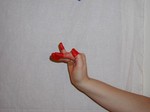Descriptions and Meanings
9:180
(c) Two hands from Caturasra position are held obliquely facing each other. This is called Tālamukha.
9:176
Talamukha—the two hands from the Caturasra position to be held obliquely facing each other.
No verse annotation
Tala-mukha (palms facing): two hands raised face to face before the chest, (not touching). Patron deity Vijnaraja.
No verse annotation:
embrace, stout things, a thick pillar, a sweet-sounding drum.
Not included elsewhere
8:506-507
If two hands are raised face to face (not touching / at a distance) before the chest, it is Talamukha (palms facing) hasta. Its presiding deity is Vinayaka.
Not included elsewhere
8:551-552
If two Pataka hastas, opposite to each other, are moving, it will be Talamukha hasta.
8:551-552:
This hasta is used to denote - Bhujangasukshma natyam, Mukha natyam, union, understanding and stout objects.
4:1240-1241
Talamukha: The two hands which are in Haṁsapakṣa Hasta are raised and placed obliquely facing each other in front of the chest.
7:85
Talamukha : When the hands are positioned in the chest horizontally, it is talamukha.
Not included elsewhere
2:241
The caturaśra hands are turned to haṁsapakṣa as before. Facing each other, they traverse the corners and reach their respective sides. These are the talamukha hastas, to be used in the graceful playing of the drums.
7:112
If the udvṛtta [saṁyutahasta] are held obliquely at the sides, it is recognised to be talamukha.
3:480
When the hands in udvṛtta [are changed] to haṁsapaksha at the sides obliquely with the palms facing each other, it is known as talamukha.
3:480:
It is prescribed by the experts to indicate the sweet sound of drums.





